Nomenclature and isomerism, Preparation, Physical and Chemical properties, Mechanism, Uses, IUPAC name, structural formula | Hydrocarbons | Chemistry - Alkynes | 11th Chemistry : UNIT 13 : Hydrocarbons
Chapter: 11th Chemistry : UNIT 13 : Hydrocarbons
Alkynes
Alkynes:
Alkynes
are unsaturated hydrocarbons that contain carbon-carbon triple bonds in their
molecules. Their general formula is CnH2n-2. The first
member of alkyne series is Ethyne popularly known as acetylene. Oxyacetylene
torch is used in welding.
Nomencluture of alkynes:
Let us write the IUPAC name for the
below mentioned alkynes by applying the general rules of nomenclature that we
already discussed in unit No.11
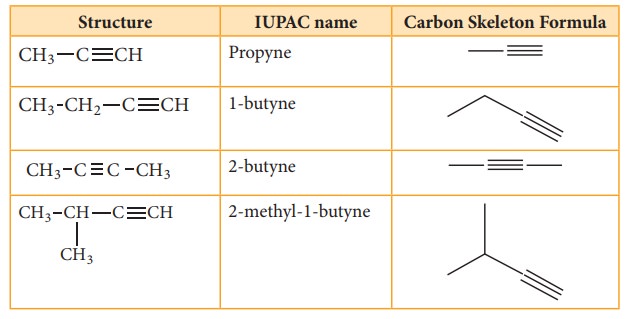
General Methods Of Preparation Of Alkynes
1. Preparation of alkynes from alkenes:
This process involves two steps:
(i)
Halogenation of alkenes to form vicinal dihalides
(ii)
Dehalogenation of vicinal dihalides to form alkynes.

2. Preparation of alkene from gem dihalides:
A
compound containing two halogen atoms on the same carbon atom is called gem
dihalide (Latin word 'Gemini' means twins). On heating with alcoholic KOH, gem
dihalides give alkynes.
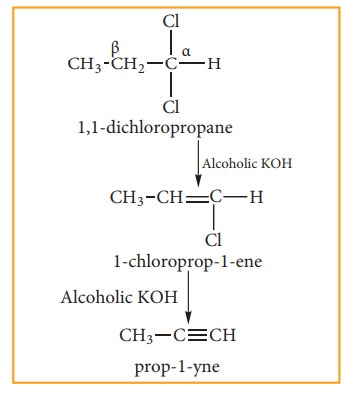
3. Preparation Of Alkenes From Elec-trolysis Of Salts Of Unsaturated Di-carboxylic Acids. (Kolbe’s Electrolytic Method)
Electrolysis
of sodium or potassium salt of maleic or fumaric acid yields alkynes.
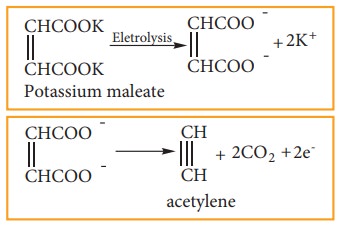
4. Industrial prefaration of ethyne:
Ethyne
can be manufactured in large scale by action of calcium carbide with water.

Calcium
carbide required for this re-action is prepared by heating quick lime and coke
in an electric furance at 3273 K

Physical properties of alkynes:
1.
The first three members are gases, next eight are liquids and the higher
alkynes are solids. They are all colour-less and odourless except acetylene
which h as a garlic odour.
2. They are slightly soluble in water but dissolve readily in organic solvents like benzene, acetone and ethyl alcohol
Chemical properities of alkynes
Terminal
Alkynes are acidic in nature. It un-dergoes polymerization and addition
reaction.
1. Acidic nature of alkynes:
An
alkyne shows acidic nature only if it contains terminal hydrogen. This can be
explained by considering sp hybrid orbitals of carbon atom in alkynes. The
percentage of S-character of sp hybrid orbital (50%) is more than sp2
hybrid orbital of alkene (33%) and sp3 hybrid orbital of alkane
(25%). Because of this, Carbon becomes more electronegative facilitating
donation of H+ ions to bases. So hydrogen attached to triply bonded
carbon atoms is acidic.

2. Addition reactions of alkynes
i) addition of hydrogen

ii) Addition Of Halogens:
When
Br2 in CCl4 (Reddishbrown) is added to an alkyne, the
bromine solution is decolourised. This is the test for unsaturation.

iii) Addition Of Hydrogen Halides:
Reaction
of hydrogen halides to symmetrical alkynes is electrophilic addition reaction.
This
reaction also follows Markovnikoff’s rule.

Addition
of HBr to unsymmetrical alkene follows Markownikoff’s rule.

iv) Addition Of Water:
Alkynes
undergo hydration on warming with mercuric sulphate and dilute H2SO4
at 333K to form carbonyl compounds.

3. Ozonolysis:
Ozone
adds to carbon-carbon triple bond of alkynes to form ozonides. The ozonides are
hydrolyzed by water to form carbonyl compounds. The hydrogen peroxide (H2O2)
formed in the reaction may oxidise the carbonyl compound to carboxylic acid.
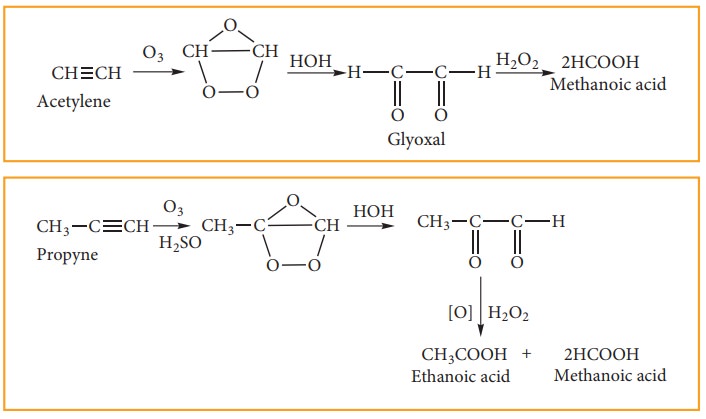
4. Polymerisation:
Alkyne
undergoes two types of po-lymerisation reaction
(i) Linear Polymerisation:
Ethyne
forms linear polymer, when passed into a solution of cuprous chloride and
ammonium chloride.
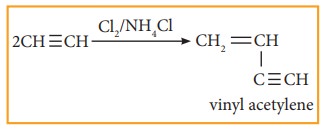
(ii) Cyclic Polymerisation:
Ethyne
undergoes cyclic polymeriza-tion on passing through red hot iron tube. Three
molecules of ethynepolymerises to benzene.
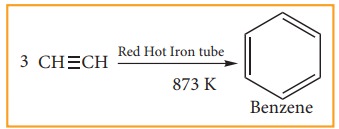
Uses of Alkynes
1.
Acetylene is used in oxy acetylene torch used for welding and cutting met-als.
2.
It is used for manufacture of PVC, polyvinyl acetate, polyvinyl ether, orlon
and neoprene rubbers.
Related Topics